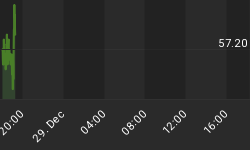US equities have been going up for so long that most investors -- especially those who were only recently enticed into the casino by the apparently easy money on offer -- have trouble remembering the last time it was possible tolose big in stocks.
Along the way, a whole slew of indices and indicators have drifted into their historical danger zones, prompting many in the financial media to address the subject, either by making explicit predictions (YouTube is now full of recent videos with pundits hammering the "get out while you can" theme) or considering the issue from unusual angles. Here's a good example of the latter from MarketWatch's L.A. Little:
How you'll know if it's time for a market crash
Last week, U.S. equities dropped 2% to 3%, depending on what index you monitor. That had the financial columns full of crash warnings about the coming plunge. Now to be fair, we have seen these headlines for a while now, so it's not like they just suddenly began to appear, but the fact that there actually was some selling added a little credence to the crash worries. Sure there were a few voices of reason, but for the most part, the coming declines were all but set in stone as far as most commentators were concerned. But is that really the case? Is it finally time for a crash?A year ago, almost to the day, I penned a piece here on MarketWatch that outlined the technical structure that precedes a crash. You can read that original column here and the follow-up column as well. Back then, the crash chorus was rising as well. The most important points of the columns were:
-
Market crashes have a technical structure that forms prior to the crash
-
Significant market declines (not crashes) also have the same exact structure
-
The technical structure is a necessary but not a sufficient condition
That last point is a salient one. What it says is that given historical data, large declines and crashes have a structure we can identify, but just because the structure is present does not necessarily mean those declines will be realized.
What is the structure? It is the break of multiple swing points on multiple timeframes across the major indexes and, in case you are wondering, we don't have that yet . In fact, we haven't seen that since that piece was penned a year ago. We came close a couple of times -- once late last year and again earlier this year, but so far, nothing yet. Remember, even when we do get the breaks and the trend transitions that they imply, it still doesn't follow that we will necessarily get a large decline or crash -- it just raises the possibility and the resultant odds.
So what would it take to get a larger decline at this juncture? If you take the weakest index, the Russell 2000, it would need to decline another 3.7%, which is equal to another decline of equal size to last week's push lower. That would bring it to the brink.
The same is true of the S&P 500 as a decline of another 3.5% from Monday's closing levels would also bring it to breakdown levels
The conclusion of the MarketWatch analysis is that US equities are one really bad day (or another week like last week) from falling off of the table. Without pretending to know the future, this seems technically reasonable, since big trends tend to continue once they get going, and psychologically consistent, since so many people are waiting for such an occurrence and are presumably primed to sell and/or short this market in a big way.
In any event, a stock market correction isn't much of a story, since there have been dozens of them in the average adult's lifetime. Way more interesting are 1) the reasons for the long bull market and 2) the likely response of the world's governments to a, say, 20% decline in the average stock. In a nutshell:
The S&P 500 has gone an amazing 33 months without a 10% correction because the world's central banks have pushed interest rates down to levels that make equities the only game in town. Major corporations now find it more profitable to borrow cheap money and buy back their stock than to actually invest in their businesses. This year they'll devote nearly a trillion dollars to this "strategy."
Central banks, meanwhile, are beginning to invest in equities directly, something they've never before done on this scale. In both cases, the buyers are not bothering to analyze their purchases, they're just steadily accumulating. This consistent inflow of funds gives the market an upward bias and stops minor corrections before they start.
As for how the word's governments will react to a serious equities bear market, that's easy. They'll do what they've done for the past 30 years: pump more newly-created currency into the financial markets. What was once known as the "Greenspan put" is now a global guarantee of paper profits in risky assets. The European Central Bank, People's Bank of China and Bank of Japan will all join the Fed in trying to stop a correction from turning into something worse. And in the process they'll lead speculators to even more bizarre flights of fancy in whatever sector is hot next time around.
This will go on until the ammo stops working. That is, when fiat currencies stop functioning as money and the world's central banks lose the ability to fool us by manipulating what used to be free markets.















